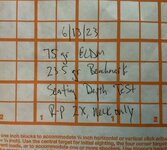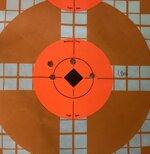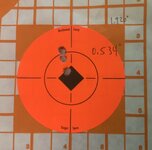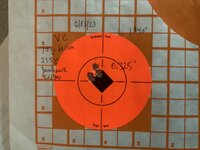Navigation
Install the app
How to install the app on iOS
Follow along with the video below to see how to install our site as a web app on your home screen.
Note: This feature may not be available in some browsers.
More options
Style variation
You are using an out of date browser. It may not display this or other websites correctly.
You should upgrade or use an alternative browser.
You should upgrade or use an alternative browser.
Seating depth - does it even matter?
- Thread starter Harvey_NW
- Start date
Have you tried jumping them like 50 or 60 thou? Mark Gordon has a ton of published data about seating depth being way more forgiving with jump and less susceptible to vertical dispersion at long distances.I do a charge test in .5 gr increments up to pressure 2 thou off the lands, then an OCW at 2 thou off the lands, in this particular case it shot around a 5/8” average at 2 thou off so I worked away from the lands in .002 increments. The groups tightened up between .006-.008 off the lands and then started opening up again after that.
Yeah bergers seating depth test suggests bigger jumps and I typically try it out to about 120 thou off. Although usually they haven’t shot for me and I end up seated closer to the lands again. My dads 7mag shooting the 175 eldx is seated 140 thou off and shoot tremendously well
Buglebrush
WKR
- Joined
- Mar 18, 2014
- Messages
- 532
I'm generally in agreement with your reply to my post, however in the case of ABLR's it does make an enormous difference and I have shot 10 & 20 shot groups to prove it. This forum is full of posts on people not getting ABLR's to shoot, and the solution usually lies in seating depth. They're finicky and need a big jump.I would question the first one, whether something was loose or how the rifle was positioned. But also, there's statistically about 60-70% variability to 3 shot groups. So if that were a rifle that averaged 1 MOA, statistically it can produce 3 shot groups as low as .3", and as high as 1.7", if you were to repeat it 10x. So really doesn't look that far off. I would question the repeatability of that load.
My experience aligns with what the ballisticians are substantiating, that it doesn't really matter and there will be significant variance from group to group, it takes a large sample size to see. What you will see is a lot evidence showing the variability in small sample size testing, what you won't see is the end result and the bad result during the test taken to a significant sample size and compared to prove it is in fact substantially better, and outside the statistical variability of the average group size that load produces.
Everybody says that but not one has large sample sizes proving it. If someone had at least 10 shot groups where one seating depth had an ES of 1.2" and another had as ES of .4", I'd be inclined to believe there might be a difference there. But the variability in ES is still 30-40% from the average 10 shot group sizes, so a rifle that averages .75" can produce 10 shot groups from .5" to 1". This is why I consider 3 shot confirmations invalid. I still think small sample size testing is effective if used correctly, but a 3 shot proof group tells you nothing really.
I don't think it's easy at all if you try to prove it. Shooting a 3 shot group is pretty easy, but actually proving your system and shooting ability is able to hold .5 MOA would be extremely impressive. But I find it pretty hard to even shoot a 10 shot group in the .5" range.
I'm not discrediting anyone's experience, I'm just looking for proof. Happen to have pics of those 10-20 shot comparisons? That's exactly what I was hoping to get.I'm generally in agreement with your reply to my post, however in the case of ABLR's it does make an enormous difference and I have shot 10 & 20 shot groups to prove it. This forum is full of posts on people not getting ABLR's to shoot, and the solution usually lies in seating depth. They're finicky and need a big jump.
Pharmseller
WKR
It really mattered to me today.
P
P
Pics?It really mattered to me today.
P
Pharmseller
WKR
Jimbee
WKR
- Joined
- Mar 16, 2020
- Messages
- 1,289
I'd be really interested to see the results if you repeated the same test multiple times.Sure
Tikka Varmint .223
View attachment 564736
View attachment 564739
View attachment 564737
View attachment 564738
Only four shots per group but the results were undeniable.
I expect this pattern when I do seating depth tests. Not necessarily that long BTO is better, but that group size changes with depth changes.
P
Pharmseller
WKR
Why would I want to do that?
Jimbee
WKR
- Joined
- Mar 16, 2020
- Messages
- 1,289
For science. I'm not trying to be contrary, just genuinely curious. I did a Berger seating depth test that showed me seating depth didn't matter after I increased the sample size.Why would I want to do that?
Pharmseller
WKR
How many shots would I have to take for the sample size to be sufficient?
P
P
Jimbee
WKR
- Joined
- Mar 16, 2020
- Messages
- 1,289
I'd say whatever gives the person doing the shooting/reloading confidence.How many shots would I have to take for the sample size to be sufficient?
P
At 30 shots the variability in group size is still 15-20%, so if your rifle averages 1", it will print 30 shot groups as small as .8", or as large as 1.2". The variability in 4 shot groups is about 50-60%, so if that same rifle averaged 1" 4 shot groups, it could print groups as small as .4", and as large as 1.7". That's the crux of my post, your samples look like seating depth makes a difference, but the group sizes fall within the statistical variability of 4 shot sample sizes.How many shots would I have to take for the sample size to be sufficient?
P
ID_Matt
WKR
The only reason they wouldn't is if they don't do their part^^^^^^^Spot on, except how will guys have ".25 moa guns all day" if they do that?!?!?
Pharmseller
WKR
At 30 shots the variability in group size is still 15-20%, so if your rifle averages 1", it will print 30 shot groups as small as .8", or as large as 1.2". The variability in 4 shot groups is about 50-60%, so if that same rifle averaged 1" 4 shot groups, it could print groups as small as .4", and as large as 1.7". That's the crux of my post, your samples look like seating depth makes a difference, but the group sizes fall within the statistical variability of 4 shot sample sizes.
You talk purty.
P
Similar threads
- Replies
- 2
- Views
- 198
- Replies
- 1
- Views
- 797
Featured Video
Latest Articles
- TT#64 Josh Boyd Elk Hunting Strategies for Every Season
- Aaron Davidson of Gunwerks
- TT#63 Dirk Durham’s Art of Elk Calling
- BIG Buck Stories with the Dirty Giants Podcast
- TT#62 Brian Barney Hunting Bulls without Calling
- Hoyt Alpha AX-2 SD Review
- Kuiu Kenai vs Outdoor Vitals Vario Hooded Jacket Review
- Hoyt RX-9 Ultra Review
- Hunting Vampire Bucks & Building an Optics Kit
- Darton Sequel ST2 35 Review




